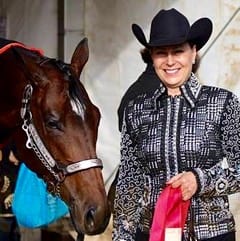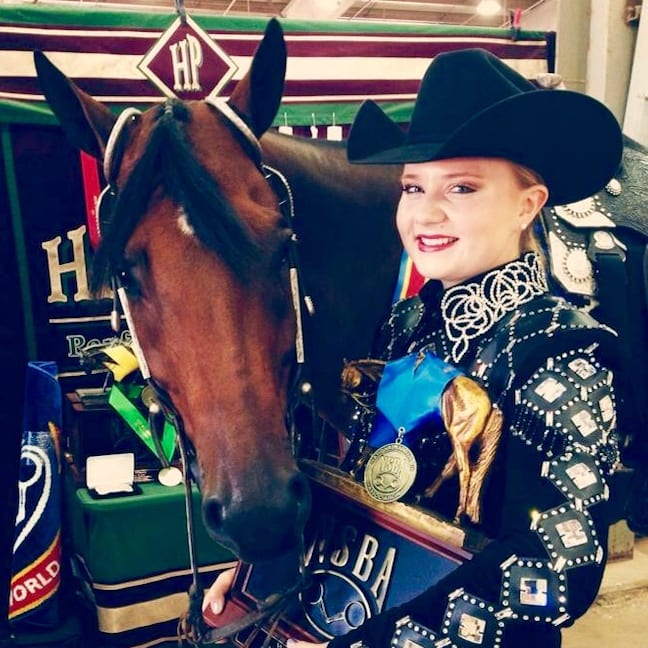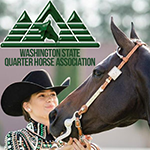Over the past several years, AQHA’s leveling program has been a hot topic for discussion around horse show arenas nationwide. The leveling program replaces the formerly known novice division and has assigned a point range for moving on to amateur or youth competition in each class through a system geared toward fairness.
According AQHA, “The aim of the AQHA leveling program is to level the playing field, with the overall goal being to get more new people involved in showing their American Quarter Horses and drive the showing market in a strong direction.”
GoHorseshow recently spoke with several competitors currently moving through the AQHA system of levels and divisions and asked them about the transition process, whether it be from youth to amateur, pointing out of Level 1 (novice), or moving into select competition.
Youth competitor Livvie Van Lanen of Green Bay, Wisconsin (pictured above) trains with Highpoint Performance Horses. Recently, Van Lanen transitioned from Level 1 (novice) division into youth competition in both western riding and horsemanship. She competes with her all-around horse All But Sudden, or Stevie. She says the transition into the youth division came rather abruptly due to her success at the 2013 All American Quarter Horse Congress.
“I had never ridden or shown western riding or trail until I started riding Stevie that summer. Stevie is the first horse I had ever changed a lead on, and the first western riding line I’ve ever loped was just 30 days before the Congress in 2013,” Livvie reveals. “That was my first time ever showing in a western riding class”
Lucky enough, the new team were Reserve Congress Champions in the Novice Youth 14-18 Western Riding, and Congress Champions in the Novice 14-18 Youth Horsemanship. “Ever since that Congress, Stevie and I have been growing as a team,” Van Lanen says.
Given her quick move into tough competition, Livvie stresses that confidence is key in remaining successful in the often-tough youth arena. “When transitioning from novice to youth, it is crucial to remain confident and ride each stride in every pattern,” Livvie reveals.
Last year, as a novice horsemanship rider, she placed fourth at the AQHA Youth World Championship Show.
“My biggest challenge during my transition was showing Stevie, who is a former western riding AQHA World Champion. For me, showing an AQHA World and Reserve World Champion in a brand new class was extremely difficult. I put so much pressure on myself to win every time because I was on Stevie, and I felt that if I didn’t do well I was letting my horse down. Once I changed my mindset, I became much more successful.”
Many competitors facing the transition out of the Level 1, formerly novice, division would likely echo Van Lanen’s sentiments concerning added pressure in their new arena.
 Exhibitor Leah Bryner of Port Royal, Pennsylvania shows her mare, Did It In A Minute, or Lexy in hunter under saddle, equitation, and showmanship. They are preparing to transition from Level 1 to amateur in each of their classes.
Exhibitor Leah Bryner of Port Royal, Pennsylvania shows her mare, Did It In A Minute, or Lexy in hunter under saddle, equitation, and showmanship. They are preparing to transition from Level 1 to amateur in each of their classes.
Bryner says, “Mentally, I had to accept that we are entering seriously tougher waters. Riding without stirrups is a necessary evil, and will only make me a better rider. Perfecting flying lead changes for pattern work is crucial to our success in Amateur Equitation, so that is a main focus in our current training. Consistency and correctness from head to toe is what wins Amateur classes, and I hope to improve upon our overall picture this year.”
Though horse showing is certainly a physically demanding sport, all who enter the arena would likely agree that it is a mental game as well. Mental toughness and preparedness certainly give any exhibitor an edge, and that preparation can be difficult for those entering deeper competitive waters.
Yet, Bryner believes the challenge can be surmounted with grit and by setting realistic, achievable goals.
“The greatest challenge has been believing that I am absolutely capable of doing what is necessary in order to win in this new division. It is incredibly intimidating knowing no room for error exists anymore,” Bryner states. “My goals are now set on proving to myself, and the people supporting me, that Lexy and I are competitive enough to hold our own against some of the best riders in the industry.”
For Bryner, last year in Level 1 was all about trying it out and doing their best, despite a lack of experience. “This year we are going for it; Lexy and I are all in!”
 Similar to moving up from the Level 1 division to amateur, every year countless successful youth make the move to amateur competition. Abi Buckwalter (pictured left) of Westminster, Maryland is one such competitor.
Similar to moving up from the Level 1 division to amateur, every year countless successful youth make the move to amateur competition. Abi Buckwalter (pictured left) of Westminster, Maryland is one such competitor.
Along with showing in AQHA all-around events on her horse, Standing Bar Time, or Gus, she also competes on the equestrian team for Delaware State University.
According to Buckwalter, the move to amateur competition has been a welcome relief from the pressure associated with the youth division’s tight timeline.
“I feel like youth was way more competitive for me. It was more cut throat because you only have eighteen years of youth, so you want to try to reach the top of youth and be successful at big shows such as the Congress and the Youth World,” Abi states. “Now that I am an amateur, I feel like it is less competitive and more relaxed.”
As Bryner and Van Lanen testified to, a change in divisions often requires learning new skills or perfecting familiar habits, but Buckwalter believes those practices that made her successful in the youth arena carry over into the amateur division.
“At the end of my youth career, we showed a lot and I practiced almost everyday, so I really didn’t change much going in to amateur,” Buckwalter says. “Since I am away at school, I go home to ride whenever I can. I think becoming one with your horse is the best way to be prepared for any class whether it be youth or amateur.”
 Exhibitor Sherrie Gultz (pictured right) of Stockton, New Jersey has been competing in the AQHA Select division for several years with her horse, Invy of Me, or Pru. Gultz competes in all-around events and much like Buckwalter, Gultz did not feel it necessary to alter her training techniques in preparation for select competition.
Exhibitor Sherrie Gultz (pictured right) of Stockton, New Jersey has been competing in the AQHA Select division for several years with her horse, Invy of Me, or Pru. Gultz competes in all-around events and much like Buckwalter, Gultz did not feel it necessary to alter her training techniques in preparation for select competition.
“I did not change my preparation for the transition into the select division, because I find that a good 90 percent of the shows use the same patterns for select as they do in amateur classes,” Gultz explains. “My priorities remain the same–prepare and execute at as high a level as I can.”
Though her approach remains the same, Gultz admits the differences between the amateur division and appreciates the opportunities available in the 50 and over division.
“The difference for me from amateur to select was that I felt I was finally moving to a division with a group of competitors more complimentary to my age. Let’s face it, as we get older our strength and stamina is not as good as it was in our 20’s and 30’s,” Gultz admits. “I am as competitive as ever and ride regularly, but I put more focus on having fun than I did before.”
Sherrie adds, “Another aspect is some people put showing horses aside temporarily to pursue a career as well as starting a family, so the select division is a great place for them to get back into showing horses.”
 Select exhibitor Camilla Cumberland of Ruffin, North Carolina agrees that no matter the division, the biggest hurdle to overcome in making the switch is often a mental one.
Select exhibitor Camilla Cumberland of Ruffin, North Carolina agrees that no matter the division, the biggest hurdle to overcome in making the switch is often a mental one.
“Preparing to make the switch from amateur to select division was only hard in my mind and that was admitting I was 50!” Camilla reveals. “My priorities in terms of practice and showing stayed the same.”
Cumberland competes in hunter under saddle events on three-year-old, Alstala Vista Baby. Like the other exhibitors, Cumberland believes only slight differences exist between divisions, and that when it comes to select competition age is the unifying factor.
“I do not feel there is a huge difference between the two divisions. Though, sometimes I feel the select, at the larger shows, has the better horses in their classes, and they seem to be quite competitive,” Camilla says. “Personally, I feel like I have to work harder as a select rider, my muscle memory retention does not come as easily as it did when I was younger. As one gets older, one is not as flexible and agile as they were when they were younger. So, in some ways it’s tough competing against younger people.”
Cumberland adds, “I know I do not stay as physically fit and I run out of breath and energy much faster than I used to. I feel in the select division we all have much more in common than when I was showing in the amateur.”
Often times, exhibitors make significant changes—from horses, to attire, to trainers— when moving on to new levels of competition, but those interviewed believe that such changes are not always necessary.
Cumberland says, “I really didn’t make any changes when moving on to the select division other than now I can afford to buy new show clothes. I still like showing the younger horses and doing the futurities, so that is all the same.”
Gultz agreed, “Age is the only difference. If nothing else, I actually try to show in more classes now than ever before.”
Sometimes it is necessary to make wardrobe updates, but according to Buckwalter, even that can be done conservatively. “I think once I finish college; I will probably get some new outfits, but for now I am happy with what I have. But I do think it is important to have mature looking clothes as you transition to show that you are an amateur and not a youth.”
Bryner also stated that less is often more. “No major changes were made in our transition, other than a new helmet and a pair of breeches that fit like they were custom made. The right fit and a classic look make all the difference in English attire, in my opinion.”
Competitors offered the following advice for those about to, or who have recently changed divisions.
Livvie Van Lanen: I think the key is confidence. You need to have confidence in your horse, your trainers, and most importantly yourself. With confidence and hard work you can succeed in the youth division.
Abi Buckwalter: I would say to any youth to enjoy every last minute of youth because it’s the best time. I miss my youth years but moving to amateur isn’t bad at all. You just have to get used to showing with a different group of people and know that you are just as good and can hang with the “big dogs” and eventually we will work our way up the horse show “totem pole.”
Leah Bryner: My advice to competitors moving on to amateur is to find and work on your weaknesses and biggest flaws. Small improvements are far superior to no improvement.
Sherrie Gultz: My advice to anyone moving into the select division is, do not look at it as getting too old. In reality, you are now the youngest in your division, so come join us and most important of all have fun.
Camilla Cumberland: The best advice is to just jump in the pool with the rest of us. I hear the Select AQHA World show is fabulous. I have qualified but the timing never seems to be right for me to go. I hope to make it out to Amarillo soon!









